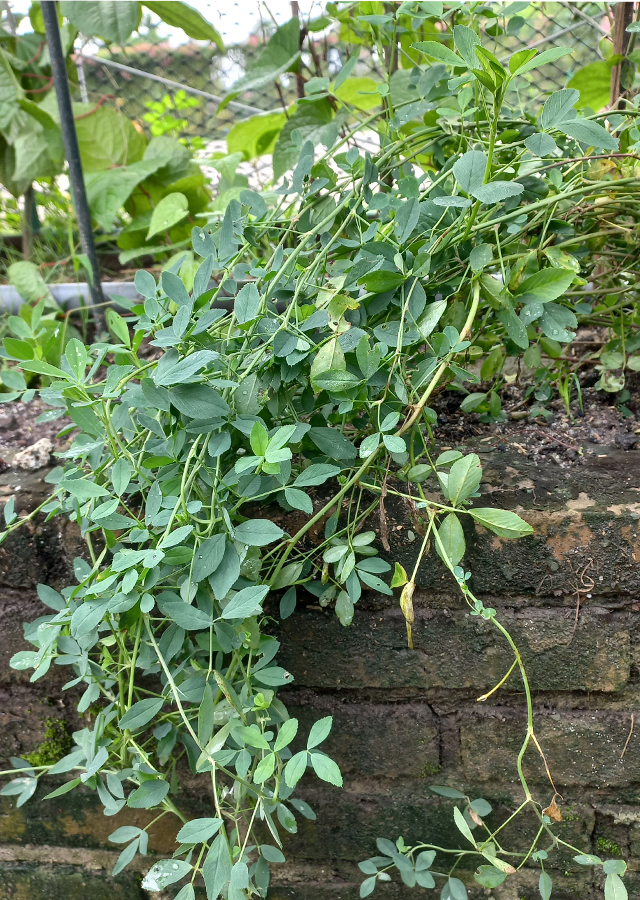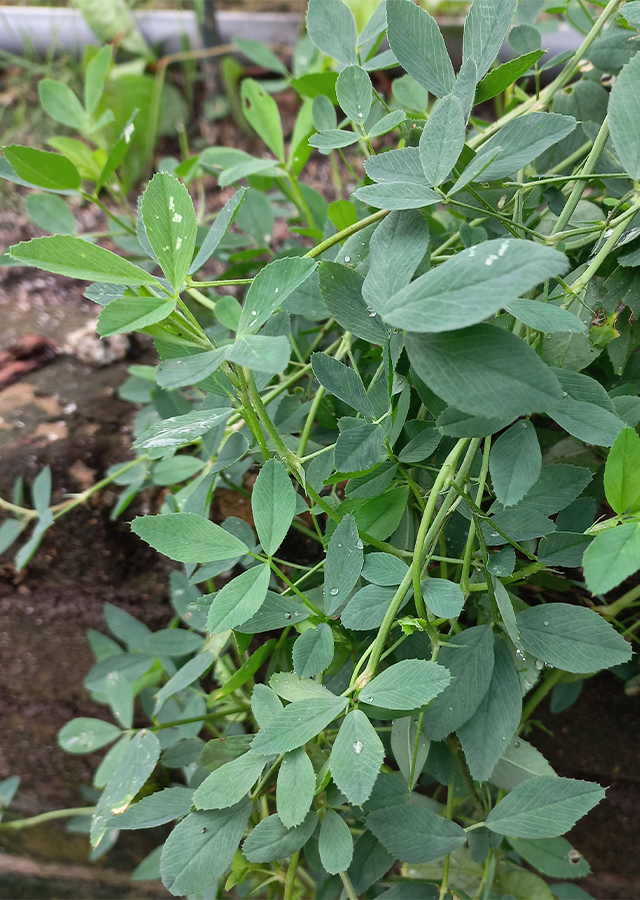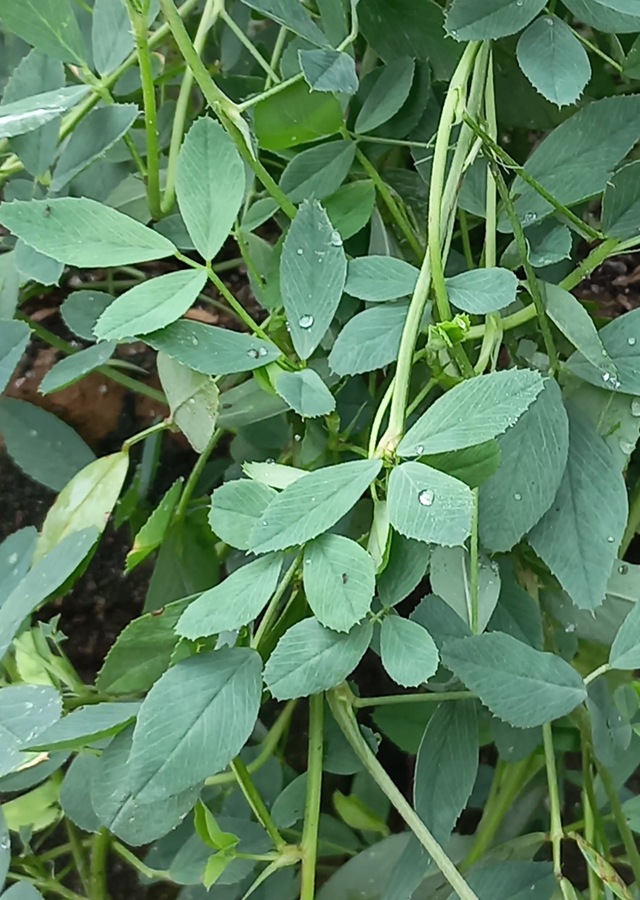Lucerne
Medicago sativa L.
Fabaceae
Location in our garden
Vegetable



Synonym
Medicago sativa subsp. vulgaris (Alef.) Arcang.
Medica sativa Lam.
Medicago afganica (Bordere) Vassilcz.
Habitus
Herbaceous. Herbaceous perennial plant, it can grow from 30 - 100 cm tall
Part Used
Leaves
Roots
Growing Requirements
Full Sunshine
Need Shade
Drought Resistant
Habitat
Riverbanks
Forest
Roadside
Grassland
Terrestrial
Overview
Lucerne is derived from Arabic al-fac-facah, which means "Father of all foods". Lucerne is thought to have originated in Iran and has been used as a fodder plant since Roman times. North America is currently the largest producer of lucerne, followed by Europe, South America, and Asia. Lucerne is grown in many other parts of the world, from China to Spain, Sweden to North Africa. Lucerne has a high vitamin and protein content so that sprouts, young leaves and shoots are used as vegetables added in making salads. Besides being able to be consumed lucerne is also useful in traditional medicine and as one of the a cosmetic ingredient.
Vernacular Names
Alfalfa, Buffalo grass, Buffalo herb, Purple mediic, Purple medicle (English).
Agroecology
Medicago sativa is a plant of the temperate to subtropical zones of Europe, Asia and N. Africa, where it is found at elevations up to 4,000 m. It grows best in areas where annual daytime temperatures are within the range 21 - 27 °C, but can tolerate 5 - 45 °C. When dormant, the plant can survive temperatures down to about -25 °C, but young growth is more tender and can be severely damaged at 0 °C. It prefers a mean annual rainfall in the range 600 - 1.200 mm, but tolerates 350 - 2.700 mm. Grows best in a sunny position, but tolerates light shade. The plant succeeds on a wide variety of soils, but thrives best on a rich, friable, well-drained loamy soil with loose topsoil supplied with lime. It does not tolerate waterlogging and fails to grow on very acid soils. Grows well on light soils. The plant has a deep taproot and, once establishd, tolerates drought and extremely dry conditions, though it will become dormant in severe drought. Prefers a neutral fertile soil but succeeds in relatively poor soils so long as the appropriate Rhizobium bacteria is present. Prefers a pH in the range 6,5 - 7,5, tolerating 4,3 - 8,7.
Morphology
- Rooting - Deeply penetrating taproot.
- Stems - Ascending to erect, arising from a woody base.
- Leaf - Trifoliate, stipules triangular, 5 to 15 millimeters long, pubescent on the lower surface, glabrous on the upper surface, and joined at the base, coarsely toothed. Petiole is pubescent, 5 to 30 millimeters long. Leaflets are narrow, oblong to ovate or obovate, 8 to 28 millimeters by 3 to 15 millimeters, dentate near the apex.
- Inflorescence - In dense racemes, containing 10 to 35 flowers, on peduncles 1 to 5 centimeters long; pedicel 1.5 to 2 millimeters long; calyx 5-lobed and 3 to 6 millimeters long; corolla purple or blue, rarely white, with yellow cultivars.
- Pod - Curled through 2 to 5 coils of 3 to 10 millimeters in diameter, indehiscent, containing 2 to 6 seeds. Seeds are yellow to brown, kidney-shaped to ovoid, 1 to 2.5 millimeters by 1.0 to 1.5 millimeters.
Cultivation
Popagation by seeds. Pre-soak the seed for 12 hours in warm water and then sow in spring in situ.
Chemical Constituents
Acids (lauric, maleic, malic, malonic, myristic, oxalic, palmitic, quinic), alkaloids (stachydrine, homostachydrine), amino acids (arginine, asparginine, cystine, histidine, isoleucine, leucine, methionine, tryptophan, valine), the non-protein aminoacid canavanine, coumarins (medicagol), isoflavonoids (coumestrol, biochanin A, genistein), saponins, steroids (campestrol, cycloartenol, β-sitosterol), tannins, cardiac glycosides, flavonoids (naringenin, apigenin, apigenin, quercitin, myrcitin and daidezin), phenolics (gallic acid, pyrogallol, salicylic acid, and caffeic acid).
Traditional Medicinal Uses
- Decoction used to boost energy.
- Anecdotal reports on use as diuretic, treatment of bladder problems, diabetes, dyspepsia, and asthma.
- In South American traditional medicine, used for diuresis, kidney and vesicular swelling, and lung ailments.
- In Morocco, liquid porridge made of pounded lucerne seeds given to newly delivered mother with no milk.
- In China, used to treat fever; in India to treat ulcers; in Iran and Turkey to treat arthritis, in the US n some natural therapies for cancer. Also used for urinary tract infections, menopause, fatigue, and asthma.
- Lucerne leaves, either fresh or dried, have traditionally been used as a nutritive tonic to stimulate the appetite and promote weight gain. The plant has an oestrogenic action and could prove useful in treating problems related to menstruation and the menopause. Some caution is advised in the use of this plant, however. It should not be prescribed to people with auto-immune diseases such as rheumatoid arthritis. See also the notes above on toxicity. The plant is antiscorbutic, aperient, diuretic, oxytocic, haemostatic, nutritive, stimulant and tonic. The expressed juice is emetic and is also anodyne in the treatment of gravel. The plant is taken internally for debility in convalescence or anaemia, haemorrhage, menopausal complaints, pre-menstrual tension, fibroids etc.
- A poultice of the heated leaves has been applied to the ear in the treatment of earache. The leaves can be used fresh or dried.
- The leaves are rich in vitamin K which is used medicinally to encourage the clotting of blood. This is valuable in the treatment of jaundice.
- The plant is grown commercially as a source of chlorophyll and carotene, both of which have proven health benefits. The leaves also contain the anti-oxidant tricin.
- The root is febrifuge and is also prescribed in cases of highly coloured urine. Extracts of the plant are antibacterial
Part Used
Reference Sources
- Stuartxchange. 2020. Phipphine Medicinal Plants: Galeria. http://www.stuartxchange.org/Galeria. 24-10-2021.
- Useful Tropical Plants. 2021. Medicago sativa. http://temperate.theferns.info/plant/Medicago+sativa. 24-10-2021.

